Difference between revisions of "User:Heritagefutures"
(→Mamiya Six III) |
(→Mamiya Six I) |
||
| Line 90: | Line 90: | ||
<b>Technical details</b> <br> | <b>Technical details</b> <br> | ||
| − | :All units are covered with leatherette with exposed chrome top housing and bottom- | + | :All units are covered with leatherette with exposed chrome top housing and bottom-plate The camera has a slightly larger [[Mamiya_Six_Design_Variations#Name Plate | waist level viewfinder]] (12 x 12 mm) than the subsequent models. The round viewfinder window on the front has a serrated edge to it, while it is smooth on the later models. Model I the only Mamiya Sox design with small eyelets for a neck strap. Other charcatreostics are: a [[Mamiya_Six_Design_Variations#Knobs and Struts| solid knurled film winding knob]], a raised button (on the top plate) to release the front door; indicator arrow next to the film counter is a [[Mamiya_Six_Design_Variations#Lettering and Labelling| pointed arrow with a thin tail]]; the shutter release button has a rounded top. |
<b>Dimensions:</b> <br> | <b>Dimensions:</b> <br> | ||
Revision as of 21:25, 6 December 2010
Contents
- 1 Collection Interests (eclectic)
- 2 Websites
- 3 MY SANDBOX
- 4 PAGE 2 Mamiya Six Design Variations
Collection Interests (eclectic)
- Simmon-Omega/Koni-Omega/Rapid Omega family of cameras
- Japanese aerial and other military cameras
- Foth & Co cameras and binoculars
- Konica model I cameras (variants)
- Cameras with Gitzo Shutters and Gitzo gear (older stuff preferred)
- Konishiruku and Rukuoh-Sha (not systematic)
- Mamiya Six cameras (variants)
Websites
MY SANDBOX
This article is about the spring-folder camera made in the 1940s and 50s. For the 1990s camera, see Mamiya 6.
The Mamiya Six is a series of 6×6 folders with a coupled rangefinder, made by Mamiya from 1940 to the 1950s. All of them are focused by moving the film plane, rather than the more common front-cell focussing of other folders of the time.
Evolution
The Mamiya Six I, II and III were wartime and immediate postwar models which had both eye-level and waist-level finders. The coupled rangefinder was combined with the eye-level finder. As a result, there were three windows at the front of the top housing. The Mamiya Six III added an exposure counter with double exposure prevention.
With the Mamiya Six IV, introduced in 1947, the waist-level finder disappeared. It remained the sole model until 1953. The Mamiya Six V added the dual 6×6 and 4.5×6 format capability, with an exposure counter functioning with both formats. The Mamiya Six K was a simpler model, with film advance via red windows.
In 1955, the Mamiya Six IVB introduced a squarer body design, easily recognized by the square rangefinder window. Its features were similar to the model IV. The Mamiya Six K2 was similar to the model K with the new body. The body design was slightly modified again for the Mamiya Six IVS and simpler Mamiya Six P.
From 1955, the Mamiya Six Automat and the later Automat 2 added a coupling between the shutter cocking and the film advance.
Given the quite erratic nature of model numbering that occurred over the years, the chronology of the thirteen major Mamiya Six models is set out in Table 1. The characteristcs of the individual models, as well as the variants within these models, are described further below. If in doubt about some of the features mentioned in the type descriptions, please refer to the visual documentation of the critical elements which provides a dichotomous key as well as a series of illustrations showing the model-specific details.
Table 1 Chronology of Mamiya Six Cameras
| Release Date | Model/Variant |
| 1940, September | Mamiya Six I |
| 1941, January | Mamiya Six Ia |
| 1942, January | Mamiya Six III |
| 1943 | Mamiya Six II |
| 1947 | Mamiya Six IV |
| 1953, November | Mamiya Six V |
| 1954, August | Mamiya Six K |
| 1955, May | Mamiya Six IVb |
| 1955, December | Mamiya Six Automat |
| 1956, March | Mamiya Six K2 |
| 1957, May | Mamiya Six IVb |
| 1957, October | Mamiya Six IVs |
| 1957, December | Mamiya Six P |
| 1958 | Mamiya Six Automat 2 |
Pre-War and War-Time Models
The first model was released in December 1940. Until the end of the World War II, the Mamiya Six was significantly modified at least three times: first in early 1941 (model Ia) with two additional models introduced in the next two years. Erratically, model III was released in 1942 (according to the official Mamiya history website[1] before model II (1943). All pre-war and war-time models have a set of range finder windows and a seperate waist-level brillant-type viewfinder, resulting in three windows at the front. All units have a single red film frame counter window counter on the back with a horizontal slider. The pre-war and war-time models were all 6x6 format cameras.
Mamiya Six I
The camera was advertised in September 1940[2] and released in December 1940 at a price of ¥248[3]
Technical details
- All units are covered with leatherette with exposed chrome top housing and bottom-plate The camera has a slightly larger waist level viewfinder (12 x 12 mm) than the subsequent models. The round viewfinder window on the front has a serrated edge to it, while it is smooth on the later models. Model I the only Mamiya Sox design with small eyelets for a neck strap. Other charcatreostics are: a solid knurled film winding knob, a raised button (on the top plate) to release the front door; indicator arrow next to the film counter is a pointed arrow with a thin tail; the shutter release button has a rounded top.
Dimensions:
- 140 x 103 x 51mm (closed), weight 780g.
Lens and shutter combinations:
- Interestingly, Mamiya offered purchasers to bring their own lenses, which would be installed in the '0' shutters. This resulted in a range of known shutter combinations.

|

|
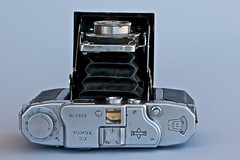
|

|
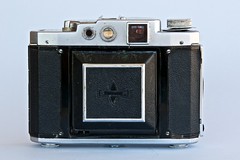
|
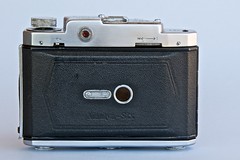
|
| Mamiya Six Model I sn# 2854 with K.O.L. Anastigmat 75mm f/3.5 in MSU-TOKYO NEW HIT shutter. Images by Dirk HR Spennemann. (Image rights) | ||
Mamiya Six Ia
The next iteration, publicised in January 1941[5] saw the use of a larger shutter, which required the redesign of the strut system. [6] The camera sold for ¥298.
Technical details
- All units are covered with leatherette. The camera has a slightly larger waist level viewfinder (12 x 12 mm) than the subsequent models. The film respool knob is a solid knurled knob. The indicator arrow next to the film counter is a pointed arrow with a thin tail
Dimensions:
- 140 x 103 x 51mm (closed), weight 780g.
Lens and shutter combinations:
- K.O.L. Special 75mm f3.5 in NKS–TOKIO '0' shutter with T, B, 1-1/200 sec (standard)[7]
- K.O.L. Special 75mm f3.5 in ¶¶¶ '0' shutter with T, B, 1-1/200 sec (standard)

|
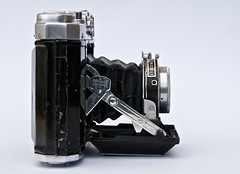
|
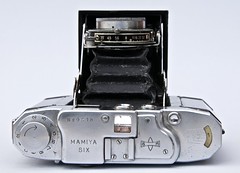
|
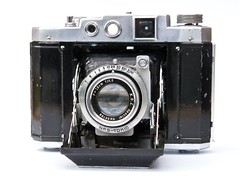
|
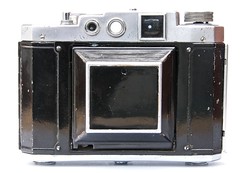
|
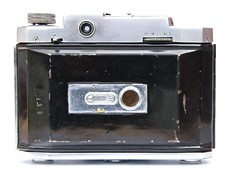
|
| Mamiya Six Model Ia sn#9518 [Kajiro_Kōgaku|K.O.L.]] Special 75mm f3.5 in NKS–TOKIO '0' shutter with T, B, 1-1/200 secImages by Dirk HR Spennemann. (Image rights) | ||
Mamiya Six II
The camera was introduced in ¶¶ 1943.[8] Even though numbered Mamiya II, this is in fact the third model to have been introduced. Like the Mamiya Six Ia, this model has a red double exposure warning pane in the rangefinder window. The Mamiya Six II is essentially a Mamiya Six III design without the flash contacts. Thus, in common it also has the slightly smaller waist level viewfinder (10 x 10 mm) and a smooth rim to the central viewfinder window.
Technical details
- Like the Mamiya Six III from which this model is dereived, the Six II has a smaller waist level finder (10 x10 mm) and the dimpled shutter release button.
Dimensions:
- TEXT TEXT TEXT
Lens and shutter combinations:
- TEXT TEXT TEXT
Mamiya Six III

|
| Double exposure warning mark in viewfinder of a Mamiya Six III Images by Dirk HR Spennemann. (Image rights) (Image rights) |
The camera was introduced in ¶¶ 1942[9] The camera was fitted with a double exposure warning system, comprised of a small transparent, red coloured half-pane that would appear in the rangefinder window.
Double exposure warning mark in viewfinder. Flash contact.
Technical details
- The Mamiya Six III has a smaller waist level finder (10 x10 mm) window on the top late, while the round viewfinder window on the front has a smooth edge. The shutter release button now has a slight depression (dimple) in the top.
Dimensions:
- TEXT TEXT TEXT
Lens and shutter combinations:
- Nippon Kogaku Nikkor 75mm f/4.5 in F. Deckel, München Compur Shutter
  
|
  
|
| Mamiya Six III no.23875, Compur shutter (T, B, 1–300), Nikkor 7.5cm f/4.5 lens no.75183. Pictures courtesy of eBayer badman664. (Image rights) |
Post-War Models
Production of the Mamiya Six was restarted after World War II. It is not clear whether, and to what extent units of the Mamiya Six III design were built from existing spare parts. The first new model to appear was the Mamiya IV.
Mamiya Six IV
The camera was introduced in ¶¶ 1947.[10]
Technical details
- TEXT TEXT TEXT
Dimensions:
- TEXT TEXT TEXT
Lens and shutter combinations:
- TEXT TEXT TEXT
Mamiya Six IVb
May 1955 Mamiya 6-iV B Camera body size and weight were reduced to increase compactness.
Technical details
- TEXT TEXT TEXT
Dimensions:
- TEXT TEXT TEXT
Lens and shutter combinations:
- TEXT TEXT TEXT
Mamiya Six IVs
October 1957 Mamiya 6-iV S Further reduced size and weight from type iV B with addition of built-in self-timer.
Technical details
- TEXT TEXT TEXT
Dimensions:
- TEXT TEXT TEXT
Lens and shutter combinations:
- TEXT TEXT TEXT
  
|
  
|
| Mamiya Six IV no.35446, Zuiko 7.5cm f/3.5 lens no.38265. Pictures courtesy of Adrian Gotts. (Image rights) |
Mamiya Six P
December 1957 Mamiya 6-P Economy priced version of 6-iV S.
Technical details
- TEXT TEXT TEXT
Dimensions:
- TEXT TEXT TEXT
Lens and shutter combinations:
- TEXT TEXT TEXT
Mamiya Six V
November 1953
Mamiya 6-V
Dual format (6x4.5cm and 6x6cm) with automatic film winding
adjustment. Maximum shutter speed improved to 1/500 sec.
Technical details
- TEXT TEXT TEXT
Dimensions:
- TEXT TEXT TEXT
Lens and shutter combinations:
- TEXT TEXT TEXT
Mamiya Six K
August 1954
Mamiya 6-K
Popular version of Mamiya 6-V without automatic film winding stop.
Technical details
- TEXT TEXT TEXT
Dimensions:
- TEXT TEXT TEXT
Lens and shutter combinations:
- TEXT TEXT TEXT
Mamiya Six K2
March 1956
Mamiya 6-K ii
Advanced model to type K with built-in format conversion.
(6x6 to 6x4.5cm)
Technical details
- TEXT TEXT TEXT
Dimensions:
- TEXT TEXT TEXT
Lens and shutter combinations:
- TEXT TEXT TEXT
Mamiya Six Automat
December 1955
Mamiya 6-Automat
Japan's first automatic shutter cocking by film advancing.
Technical details
- TEXT TEXT TEXT
Dimensions:
- TEXT TEXT TEXT
Lens and shutter combinations:
- TEXT TEXT TEXT
Mamiya Six Automat 2
1958
Mamiya 6 Automat 2
Most highly featured Mamiya 6 camera with Sekor lens, bright
Albada finder and other advanced features. Last model of the
original folding Mamiya 6 series cameras.
Technical details
- TEXT TEXT TEXT
Dimensions:
- TEXT TEXT TEXT
Lens and shutter combinations:
- TEXT TEXT TEXT
Notes
- ↑ History of Mamiya Six (Mamiya history website)
- ↑ Asahi Camera September 1940 Neco's Mamiya page
- ↑ Mamiya Six I (Mamiya history website)
- ↑ sn# 2854.—Photographica Collection Dirk HR Spennemann (Flickr image)
- ↑ Asahi Camera January 1941, February 1941 Neco's Mamiya page
- ↑ Mamiya Six Ia (Mamiya history website)
- ↑ sn# 9518.—Photographica Collection Dirk HR Spennemann | (Flickr image)
- ↑ Asahi Camera ¶¶¶¶¶ Neco's Mamiya page
- ↑ Asahi Camera ¶¶¶¶¶ Neco's Mamiya page
- ↑ Asahi Camera ¶¶¶¶¶ Neco's Mamiya page
PAGE 2 Mamiya Six Design Variations
This page provides a visual overview over those design elements of the Mamiya Six cameras that permit an accurate identification of the various variants.
Dichotomous Key (model Identification)
The Mamiya Six comes in a bewildering range of variants. The dichotomous key provided below provides an avenue at identifying the types of Mamiya Six. Given the confusing similarity of models and variants, it is recommended that you follow the steps, rather than scanning for criteria. When you have identified your model, click on the model name to see a full description. If you are unclear about one of the criteria, either click on the name or scroll down to the bottom of the page for visual identification guides.
How many viewfinder windows are on the front?
- Is there a horizontal bar underneath the lens?
- Yes
- The right hand, square viewfinder window is:
- Flush with the casing→Mamiya Six Automat
- Surrounded by a small back rim → Mamiya Six Automat 2
- The right hand, square viewfinder window is:
- No
- The right hand, square viewfinder window is:
- Flush with the casing
- Film Advance knob is
- Solid with film speed on top→Mamiya Six P
- Mushroom shaped
- Depth of Field Indicator is
- Film Advance knob is
- Flush with the casing
- The right hand, square viewfinder window is:
- Yes
- Surrounded by a small black rim → Mamiya Six IVs
- Surrounded by small rectangular plate
- Viewfinder housing to the left of the shutter release is
- Curved→ Mamiya Six IV
- Straight → Mamiya Six K
- Surrounded by a rectangular plate that encompasses the left round window as well → Mamiya Six V
- Does the body have triangular neckstrap lugs?
- Yes → Mamiya Six I
- No
Need ID for IA II IIA III
Sub variant options: look at numbering of the feet spacing inside the wheel Made in Japan on door closer as opposed to bottom..
Mamiya Six Ia
Mamiya Six III
Mamiya Six II
Lenses and Shutters
The Mamiya Six was manufactured in a wide range of lenses and shutters. That holds particularly true for the pre-War and War period, when prospective buyers could even bring in their own shutters and lenses to be fitted.
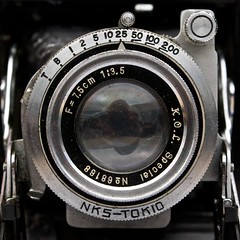 K.O.L. Special 75mm f3.5 in NKS–TOKIO shutter |
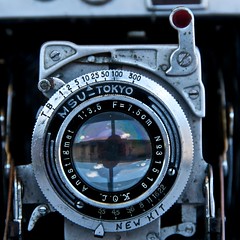 K.O.L. Anastigmat 75mm f/3.5 in MSU-TOKYO NEW HIT shutter |
http://XXX.jpg TEXT TEXT |
http://XXX.jpg TEXT TEXT |
| Lens and Shutter Combinations of the Mamiya Six. Images by Dirk HR Spennemann. (Image rights) | |||
Double Exposure Prevention
 Type I None, pull-out knob only |
 Type II shutter cocked |
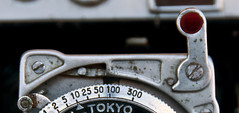 Type II shutter released |
http://XXX.jpg TEXT TEXT |
| Lens and Shutter Combinations of the Mamiya Six. Images by Dirk HR Spennemann. (Image rights) | |||
Body Shape Variations
Name Plate
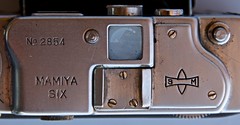 Serial Number above MAMIYA SIX 12x12mm waist view finder |
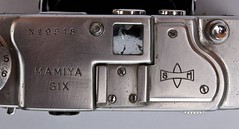 Serial Number above MAMIYA SIX 10x10mm waist view finder |
http://XXX.jpg TEXT TEXT |
http://XXX.jpg TEXT TEXT |
| Nameplate variations of the Mamiya Six. Images by Dirk HR Spennemann. (Image rights) | |||
Rangefinder Windows (front)
 Three windows, central window with serrated edge |
 Three windows, central window with smooth edge |
http://XXX.jpg TEXT TEXT |
| Rangefinder window variations of the Mamiya Six. Frontal View Images by Dirk HR Spennemann. (Image rights) | ||
 Three windows, central window with serrated edge |
http://XXX.jpg Three windows, central window with smooth edge |
http://XXX.jpg TEXT TEXT |
| Rangefinder window variations of the Mamiya Six. Top View Images by Dirk HR Spennemann. (Image rights) | ||
Flash Shoe
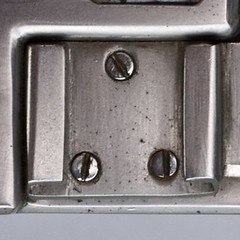 Three screws |
http://XXX.jpg Two screws oblique |
http://XXX.jpg Two screws vertical |
http://XXX.jpg TEXT TEXT |
| Flash-shoe variations of the Mamiya Six. Images by Dirk HR Spennemann. (Image rights) | |||
Film Counter Window
 Mamiya Six I |
http://XXX.jpg TEXT TEXT |
http://XXX.jpg TEXT TEXT |
http://XXX.jpg TEXT TEXT |
| Details of Film Counter Windows of the Mamiya Six. Images by Dirk HR Spennemann. (Image rights) | |||
Various
 Eye-lets for neck strap Mamiya Six I only |
http://XXX.jpg TEXT TEXT |
http://XXX.jpg TEXT TEXT |
http://XXX.jpg TEXT TEXT |
| Various Details of the Mamiya Six. Images by Dirk HR Spennemann. (Image rights) | |||
Knobs and Struts
Film Advance Knob
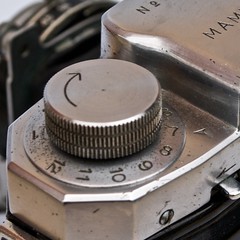 Solid, knurled Knob |
http://XXX.jpg Mushroom-shaped knob |
http://XXX.jpg Mushroom-shaped knob with film speed |
http://XXX.jpg Mushroom-shaped knob with film type |
| Variations of the film advance knob of the Mamiya Six. Images by Dirk HR Spennemann. (Image rights) | |||
Front Door Release
 raised button |
http://XXX.jpg XXX |
http://XXX.jpg XXX |
http://XXX.jpg XXXX |
| Variations of the front door release of the Mamiya Six. Images by Dirk HR Spennemann. (Image rights) | |||
Shutter Release
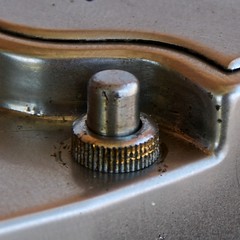 rounded top |
http://XXX.jpg dimpled top |
http://XXX.jpg cable release thred |
http://XXX.jpg XXXX |
| Variations of the shutter release of the Mamiya Six. Images by Dirk HR Spennemann. (Image rights) | |||
Lettering and Labelling
Frame Counter
 Line Arrow |
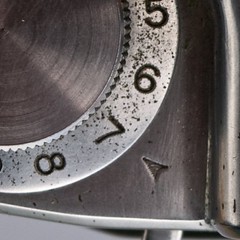 Hollow triangle |
http://XXX.jpg Hollow broad arrow |
| http://XXX.jpg Filled broad arrow |
http://XXX.jpg Filled triangle |
http://XXX.jpg Drop-shaped counter |
| Variations of the frame counter of the Mamiya Six. Images by Dirk HR Spennemann. (Image rights) | ||
Depth of Field Indicator
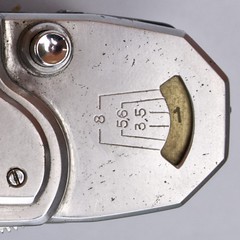 Demarcation 3.5, 8, 11 |
http://XXX.jpg Demarcation 3.5, 8, 11, 22 |
http://XXX.jpg XXX |
http://XXX.jpg XXX |
| Variations of the Depth of Field Indicator of the Mamiya Six. Images by Dirk HR Spennemann. (Image rights) | |||
Film Advance Lock
 Line Arrows |
http://XXX.jpg Filled arrows |
http://XXX.jpg Filled arrow, no '1' shown |
| Variations of the labelling of the Film Advance Lock of the Mamiya Six. Images by Dirk HR Spennemann. (Image rights) | ||
Focus Wheel
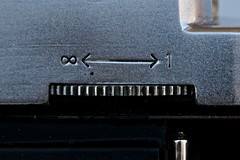 Line Arrows |
http://XXX.jpg Filled arrows |
http://XXX.jpg Filled arrow, no '1' shown |
| Variations of the focus wheel of the Mamiya Six. Images by Dirk HR Spennemann. (Image rights) | ||
Made in Japan
| http://XXX.jpg "MADE IN OCCUPIED JAPAN" engraved on the bottom plate |
http://XXX.jpg "MADE IN OCCUPIED JAPAN" embossed in the door latch |
http://XXX.jpg TEXT TEXT |
| Placement of the designator "Made in Occupied Japan" Mamiya Six. Images by Dirk HR Spennemann. (Image rights) | ||
Labels on the Inside
 MAMIYA SIX 6x6 TOKYO NIPPON |
http://XXX.jpg TEXT TEXT |
http://XXX.jpg TEXT TEXT |
| Labels found in the back door of the Mamiya Six. Images by Dirk HR Spennemann. (Image rights) | ||